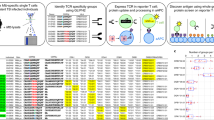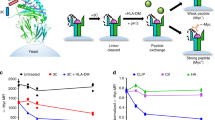Abstract
The value of predictive algorithms for identifying CD8+ T (TCD8+)-cell epitopes has not been adequately tested experimentally. Here we demonstrate that conventional bioinformatic methods predict the vast majority of TCD8+-cell epitopes derived from vaccinia virus WR strain (VACV-WR) in the H-2b mouse model. This approach reveals the breadth of T-cell responses to vaccinia, a widely studied murine viral infection model, and may provide a tool for developing comprehensive antigenic maps of any complex pathogen.
This is a preview of subscription content, access via your institution
Access options
Subscribe to this journal
Receive 12 print issues and online access
$209.00 per year
only $17.42 per issue
Buy this article
- Purchase on Springer Link
- Instant access to full article PDF
Prices may be subject to local taxes which are calculated during checkout


Similar content being viewed by others
References
Tscharke, D.C. et al. J. Exp. Med. 201, 95–104 (2005).
McCraith, S. et al. Proc. Natl. Acad. Sci. USA 97, 4879–4884 (2000).
De Groot, A.S. & Berzofsky, J.A. Methods 34, 425–428 (2004).
Oseroff, C. et al. Proc. Natl. Acad. Sci. USA 102, 13980–13985 (2005).
Pasquetto, V. et al. J. Immunol. 175, 5504–5515 (2005).
Wallace, M.E. et al. J. Virol. 73, 7619–7626 (1999).
Kast, W.M. et al. Proc. Natl. Acad. Sci. USA 88, 2283–2287 (1991).
Smith, C.L. et al. J. Immunol. 175, 8431–8437 (2005).
Terajima, M. et al. J. Exp. Med. 197, 927–932 (2003).
Jing, L. et al. J. Immunol. 175, 7550–7559 (2005).
Bray, M. & Miller, M. Clin. Infect. Dis. 38, 882–889 (2004).
Allen, T.M. et al. J. Virol. 79, 12952–12960 (2005).
Bowen, D.G. et al. J. Exp. Med. 201, 1709–1714 (2005).
Klenerman, P. & Zinkernagel, R.M. Nature 394, 482–485 (1998).
Acknowledgements
This study was funded by the National Institutes of Health (contract no. HHSN266200400024C, and RO1 grant no. RO1-AI-56268. D.C.T. is the recipient of an National Health and Medical Research Council (Australia) Howard Florey Centenary Fellowship no. 224273.
Author information
Authors and Affiliations
Corresponding author
Ethics declarations
Competing interests
The authors declare no competing financial interests.
Supplementary information
Supplementary Fig. 1
Using scoring matrices to predict the affinity of peptides to MHC-I molecules. (PDF 23 kb)
Supplementary Fig. 2
Analyzing prediction performance post-hoc. (PDF 73 kb)
Supplementary Table 1
Summary of epitope characteristics. (PDF 52 kb)
Supplementary Table 2
Structural characteristics of antigens recognized. (PDF 45 kb)
Supplementary Table 3
Summary of structural characteristics of VACV-WR antigens recognized by C57BL/6. mice (PDF 37 kb)
Supplementary Data 1
Scoring matrices used for the individual predictions. (PDF 323 kb)
Supplementary Data 2
Peptides from Vaccinia WR predicted to bind MHC molecules. (PDF 317 kb)
Rights and permissions
About this article
Cite this article
Moutaftsi, M., Peters, B., Pasquetto, V. et al. A consensus epitope prediction approach identifies the breadth of murine TCD8+-cell responses to vaccinia virus. Nat Biotechnol 24, 817–819 (2006). https://doi.org/10.1038/nbt1215
Received:
Accepted:
Published:
Issue Date:
DOI: https://doi.org/10.1038/nbt1215
This article is cited by
-
Development of a novel multi‑epitope vaccine against the pathogenic human polyomavirus V6/7 using reverse vaccinology
BMC Infectious Diseases (2024)
-
Cross-reactive MHC class I T cell epitopes may dictate heterologous immune responses between respiratory viruses and food allergens
Scientific Reports (2023)
-
A Multi-epitope Vaccine Candidate Against Bolivian Hemorrhagic fever Caused by Machupo Virus
Applied Biochemistry and Biotechnology (2023)
-
Advances in Computational and Bioinformatics Tools and Databases for Designing and Developing a Multi-Epitope-Based Peptide Vaccine
International Journal of Peptide Research and Therapeutics (2023)
-
In Silico Analysis of a Candidate Multi-epitope Peptide Vaccine Against Human Brucellosis
Molecular Biotechnology (2023)



